- I am posting this month’s minutiae article a little early,
because tomorrow I will be out of town.
These days when I am out of town I usually stay at the home of this cat:
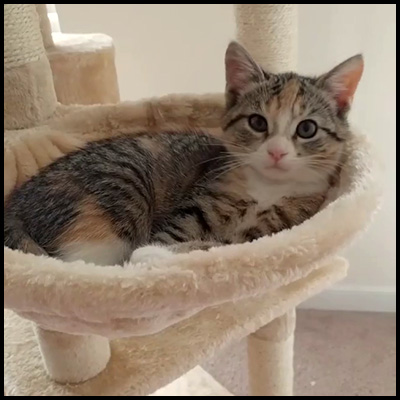
During one of these visits I noticed that the cat was basically iterating through a loop: sit on my computer, then pounce on my feet, then sit on the window sill, then sit on my computer, then pounce on my feet, etc. The same three actions, over and over, at a clockwork pace. You know who acts like this? Non‐player characters in interactive fiction games act like this! This was exactly what an IF cat’s daemon routine would look like.
- Me: (starts up car after refueling)
Radio: “…If the moon looks bigger and brighter to you tonight, you’re not imagining things—we’re ringing in the new year with a ‘supermoon’, when the moon appears larger and more luminous due to variations in its orbit around the earth.”
Me: Give me a break. It’s a tiny fraction closer. I’ve seen a million of these—if no one told you about the ‘supermoon’ ahead of time you wouldn’t even notice.
(turns toward gas station exit, looks at horizon)
HOLY FUCKBALLS SUPERMOON
- I’m still making Australian desserts.
This time around I went with rocky road, which to me was just an ice cream
flavor but which in Australia is a confection consisting of melted
chocolate mixed with marshmallows and other ingredients, then cooled (to
room temperature, according to most recipes, but as with most chocolate I
preferred it refrigerated. Call me a philistine).
Every recipe had its own set of ingredients, so I took that as a license
to improvise, and wound up going with the following:
- mixture of milk chocolate and semi‐sweet chocolate
- vegan marshmallows
- macadamia nuts (more Australian than the alternatives!)
- coconut (less than most recipes call for, though)
- amarena cherries (because glacé cherries seem to be mostly corn syrup)
And here’s how it turned out:

This dessert was very successful! Not only was it a tasty treat, but it was super easy to make. I can easily imagine this becoming a fixture in my dessert rotation.
- mixture of milk chocolate and semi‐sweet chocolate
- For a more healthful dessert, I’ve been eating a lot of apples
this month.
Most apples are terrible, so in the past I have stuck to the two varieties
that I have found to be reliable: Granny Smith and Cripps Pink (also known
as Pink Lady).
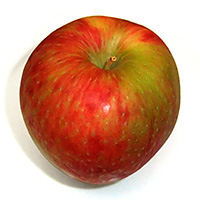 But it’s been years since I did an apple taste test and a bunch of
new cultivars have been devised in the interim, so I thought I’d try
some.
Most of these are terrible also.
But one has turned out to be my new favorite apple by a fair margin: the
unfortunately‐named “Juici”, a cross between the
Braeburn and Honeycrisp.
After ten years in development, Juici apples first hit the market in
2016.
As the name suggests, they’re significantly juicier than any
other apples I can recall trying, and they’re reliably crisp and
delicious.
Envy apples also have a good texture and a decent juice content, but the
flavor of that juice is not quite as much to my liking.
Pretty much all the other new apple varieties I’ve tried were too
mealy—bleah.
Juici is where it’s at.
But it’s been years since I did an apple taste test and a bunch of
new cultivars have been devised in the interim, so I thought I’d try
some.
Most of these are terrible also.
But one has turned out to be my new favorite apple by a fair margin: the
unfortunately‐named “Juici”, a cross between the
Braeburn and Honeycrisp.
After ten years in development, Juici apples first hit the market in
2016.
As the name suggests, they’re significantly juicier than any
other apples I can recall trying, and they’re reliably crisp and
delicious.
Envy apples also have a good texture and a decent juice content, but the
flavor of that juice is not quite as much to my liking.
Pretty much all the other new apple varieties I’ve tried were too
mealy—bleah.
Juici is where it’s at.
- When Dolores O’Riordan (a.k.a.
“her from the Cranberries”) died this month, it reminded
me of
an article I read in the Los Angeles
Times back in January of 1994, in which
music editor Robert Hilburn ran down the odds of various bands making the
Rock and Roll Hall of Fame someday.
For instance, of Nirvana he wrote that “There were so many
expectations and tensions surrounding the band after
Nevermind, the group’s landmark
1991 album, it’s a minor miracle that the
group delivered an album of even rawer power in last year’s In
Utero. Who knows how long the band will be able to maintain the
pace”—it turned out to be 15
months—“but it already has changed the face of modern
rock. Up from 10% to
40%.”
For some reason, it stuck in my head that he had put the Cranberries on
the list after just one album: “Nice sound. Nice start. But still
lots to prove. 3%.”
As it happens, musical acts whose first release was in
1993 became eligible for the Rock Hall in the
far‐flung future of 2018, and out of
curiosity I compared Hilburn’s list to the current list of actual
inductees.
All of his locks are now in, though it took Linda Ronstadt
19 years, and from his list of
up‐and‐comers, Metallica, Nirvana, and Pearl Jam are in as
well.
Then I started browsing through the list of those who are eligible
but have yet to be inducted.
Beck became eligible this year… Radiohead and Stone Temple
Pilots last year… my beloved (but so obscure I was shocked to see
them listed) Letters to Cleo in 2016…
Hole and Smashing Pumpkins and Alice in Chains in
2015… and then further down, some older
acts that really surprised me for not being in yet.
Like, no, Whitney Houston and Janet Jackson weren’t really rockers,
but neither are a lot of these acts, and they sold massive numbers of
records—yet they’ve been passed over since
2009 and 2007
respectively.
Some cult favorites with lots of critical acclaim behind them have also
been waiting for a decade or more: the Smiths since
2008, Sonic Youth since
2007, Hüsker Dü and New Order since
2006.
Somehow the Cure have been given the thumbs‐down every year since
2003!
And then here in the 2002 class is
Björk—
—wait, what? Björk is in the same class as Devo and Foreigner? But… I remember when her first album, which was actually called Debut, came out! It was 1993! She is a relative youngling—to be eligible for the Hall in 2002 she would have had to have recorded an album when she was eleven!
…and it turns out that Björk recorded an album when she was eleven. I had no idea. Actually, maybe I knew that once and forgot. But yeah, like, here’s tween Björk singing “The Fool on the Hill” in Icelandic:
So who knows? Jordy the Singing Baby’s career may have a second act yet!
- I did a sort of internship shadowing an English teacher at a nearby
public high school this month; like my own high school English teacher
back in the ’80s, he had a turntable set
up next to his desk and would play records in between
classes—not just old stuff but a lot of
21st‐century albums as well.
We chatted a little bit about how crazy it was that vinyl LPs would
take over again as the dominant form of physical media for music.
At the time I didn’t realize quite how crazy, though.
A few days later I wandered into Amoeba Music, where, yes, vinyl LPs had
colonized the space where the CDs used to be… and I was floored to
discover that they were selling for forty goddamn dollars
apiece.
Even the cheap ones were going for prices like
$28.99 and $34.99.
I couldn’t help but recall being in physics class, back in high
school, and having to put together a racecar using a mousetrap as the
engine.
This was 1988 or
’89, early enough that most everyone had
vinyl LPs lying around the house but late enough that no one actually
listened to them: cassettes had taken over, and though compact discs were
still kind of a luxury item, a lot of people had CD players too.
So most of us used old records as the wheels of our racecars.
I actually took a soldering iron to mine, to melt holes in them and
lighten the car—I remember how awful the fumes from the
vinyl smelled.
So on the big day, we all went to the gym and lined up these little
jalopies with 45s for front wheels and
33s for back ones.
And a joke went around about one of the notoriously wealthy kids from
a different class: ha ha, he’s such a Richie Rich that he probably
made his wheels out of CDs!
Big laughs all around the gym.
Thirty years later, I’m standing on the corner in front of the store where the LPs are going for thirty and forty bucks. Across the street? Another store with the signs in all the windows declaring “ALL CDS 50¢”. And by “standing on the corner” I guess I meant “standing on the corner of the cubical globe” because clearly this is Bizarro World.
- Speaking of cubes: it is more the rule than the exception that when
something first becomes popular, it doesn’t stay popular forever,
but instead recedes for a while before either continuing on into oblivion
or returning to become a permanent or recurring fixture.
Take the words “awesome” and “radical”, used
colloquially.
Both were iconic examples of ’80s
slang, and when I was in college in the early
’90s, basically no one ever said either
one, precisely because they were so very
’80s.
Then around the turn of the millennium “awesome” returned
without its generational stigma, and is now almost as universal as
“cool”, while “radical” never came back.
I had thought that Rubik’s Cubes were in the “radical”
category, but I saw several of them this month at the high school, and
I subsequently learned that, like the word “awesome”, they
had actually made a comeback around Y2K and
were no longer considered any more generationally specific than other
recurring high school fads like yo‐yos or hacky sacks.
Now I’m wondering whether if I went to an elementary school
I’d see all the kids toting around Speak & Spells.
- Some artifacts of the past should never come back, though.
I have grumbled about this before, but this month I was pissed off to
discover that my copy of Windows 10 had
been forced to update, and the new version broke the beautiful Aero skin
I had spent a couple of days installing and customizing.
Microsoft seems really insistent on infecting my computer with atavistic
flat design and unusable borderless windows.
I did manage to find some new programs that would restore my gorgeous
translucent window borders, but most of my icons are stuck on flat, as are
my scrollbars and buttons.
Skinnability used to be a selling point for
software—in the Windows 98
days Winamp had thousands of skins to choose from—and now
companies are not only failing to implement interface customization,
they’re deliberately disabling the customization that was
previously permitted.
Choosing an OS used to be like buying a house, which you could make your
own; now it’s like checking into a hotel room, where if you try to
change the drapes you’ll be thrown into the street.
I guess it’s all part of a general trend toward the concentration of
power: nothing is ours, everything is theirs.
But to be honest, I have to confess that these political underpinnings
probably wouldn’t bother me nearly as much if the hotel room were at
least nice.
What really infuriates me is less than they’re imposing upon me than
that what they are imposing upon me is so primitive.
Seriously, blank white scrollbars?
That’s a throwback to
Windows 2!
Microsoft was offering better‐looking scrollbars in
1990!
At this point I would not be shocked if OS designers’ next move were
to do away with color entirely.
After all, black and white is so much more streamlined, and you might
start using colors the designers don’t approve of!
- On the subject of bad design, I got a new floor lamp recently.
It looks pretty good, and the light it gives off is fine.
But the controls are terrible.
The big selling points of the lamp, aside from the LED power savings,
are that you can vary the color temperature of the light and that you can
dim it.
But here’s how that works.
To turn it on, you push a button.
The lamp will come on at 3000K, full
power.
To go to 4000K, you push the button again.
To go to 5000K, you push the button yet
again.
A fourth push turns off the lamp—meaning that, yes, if I have
the lamp at 3000K as I usually do, turning it off
means pushing the button three times.
To dim the lamp, you hold the button down, and then to brighten it, you let
go and hold the button down again.
Now, maybe I’m just kooky, but personally, if I want the lights dim,
it’s generally because I’ve just woken up and can’t
stand bright light just yet.
With my wonderful halogen torchieres back in the
’90s, that meant that I would turn the knob
or slide the slider ever so slightly—click!—and
it would go from dark to, like, 1% power.
Then as my eyes adjusted I could crank it up to 5%,
10%, 25%,
50%, 100%.
With this lamp?
Nope, you have to start at 100%, scream as your
retinas burst into flame, and then sit there holding the button for hours
on end while the dimmer slooooowly takes the light down to like
80%.
All because apparently we can’t have nice things like knobs
or dials anymore.
We can’t even have multiple buttons—it’s one
button per device now.
And need I add that the button doesn’t actually respond to
being pushed—that it’s just a flat thing and it’s
always 50/50 whether
your finger pressure will count as a push?
- One last item about design: one thing I find super interesting is how
rapidly design that seems fresh and modern and timeless suddenly gets
dismissed as dated and in need of a revamp.
Sometimes I disagree because I consider the “update” to be
more of a backdate, a retreat from a stylistic high‐water
mark.
As much of an Apple detractor as I am, I have to confess that when
Jennifer first installed the Aqua
GUI on her Mac, I was envious—those beautiful glass
buttons! those eye‐popping icons!—whereas the flat,
bland “High Sierra” look of today’s OS X makes me
yawn.
Other times I disagree because while I recognize that the new style has
struck off in a new direction, that direction strikes me as
ridiculous—take the new Pepsi logo that looks like the old
one melted.
But generally I actually do find myself agreeing with the consensus: more
often than not, new logos do look better to me, and then a few years later
I do start to find them dated.
Which raises the question to which all of this is a preamble.
Consider the following example, chosen basically at random: the logo of
the Seattle Supersonics, a defunct pro basketball team.
Here’s how it evolved over time:
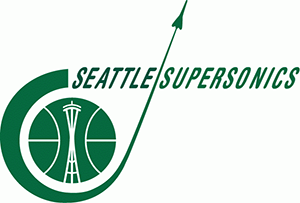 The ’60s:
Before Amazon and Microsoft, Seattle was known as the home of Boeing, and
the team was named after the supersonic
Boeing 2707 (which was canceled before
actually being built).
Correspondingly, this first logo looks like it belongs to an aerospace
company.
The font actually looks pretty sharp to me, but I can see how in the
’70s it might be deemed too corporate.
The ’60s:
Before Amazon and Microsoft, Seattle was known as the home of Boeing, and
the team was named after the supersonic
Boeing 2707 (which was canceled before
actually being built).
Correspondingly, this first logo looks like it belongs to an aerospace
company.
The font actually looks pretty sharp to me, but I can see how in the
’70s it might be deemed too corporate.
 The ’70s:
So here we have a chunky, funky font with gaudy stripes like a
’70s tie, with hornlike S’s
reflecting a rebranding from aerospace to music.
This may have struck people as groovy in 1971
but when I saw this as a kid in the ’80s
I laughed and laughed.
The ’70s:
So here we have a chunky, funky font with gaudy stripes like a
’70s tie, with hornlike S’s
reflecting a rebranding from aerospace to music.
This may have struck people as groovy in 1971
but when I saw this as a kid in the ’80s
I laughed and laughed.
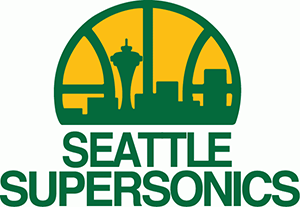 The ’80s:
On the other hand, as a kid in the ’80s I
was always wowed by this lettering—I didn’t know what
Helvetica was, but I knew that this looked crisp and modern and was
obviously a dramatic improvement over the goofy logo with the
saxophones.
But then by the time the ’90s rolled
around, this did seem like it was showing its age.
In an era full of colorful, cartoony logos boasting growling mascots and
Adobe Illustrator effects, the Sonics offered a sedentary wordmark and
a city skyline with exactly one distinctive building in it.
The ’80s:
On the other hand, as a kid in the ’80s I
was always wowed by this lettering—I didn’t know what
Helvetica was, but I knew that this looked crisp and modern and was
obviously a dramatic improvement over the goofy logo with the
saxophones.
But then by the time the ’90s rolled
around, this did seem like it was showing its age.
In an era full of colorful, cartoony logos boasting growling mascots and
Adobe Illustrator effects, the Sonics offered a sedentary wordmark and
a city skyline with exactly one distinctive building in it.
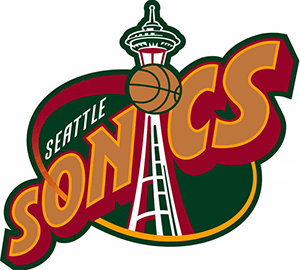 The ’90s:
So this looked like a huge upgrade!
Swooping!
Three‐dimensional!
Fun!
And colorful, though even at the time I was dubious: the red seemed like a
mistake, and the brown seemed like a catastrophe.
Anyway, this turns out to be a perfect example of something that looked
amazing when it debuted and then looked like an embarrassing relic about
five minutes later.
The ’90s:
So this looked like a huge upgrade!
Swooping!
Three‐dimensional!
Fun!
And colorful, though even at the time I was dubious: the red seemed like a
mistake, and the brown seemed like a catastrophe.
Anyway, this turns out to be a perfect example of something that looked
amazing when it debuted and then looked like an embarrassing relic about
five minutes later.
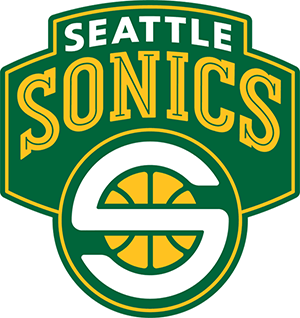 The 21st century:
Thus, this logo was pretty much universally applauded when it replaced
the ’90s logo; people said that it struck a
good balance between jazziness and restraint, and that it paid homage to
the skyline logo without being poisoned by that logo’s
’80s‐ness.
This logo premiered in 2001, so it’s
likely that some aspect of it would by now have been deemed in need of
freshening up.
(Instead the team got moved to Oklahoma City under, shall we say,
eyebrow‐raising circumstances.)
The 21st century:
Thus, this logo was pretty much universally applauded when it replaced
the ’90s logo; people said that it struck a
good balance between jazziness and restraint, and that it paid homage to
the skyline logo without being poisoned by that logo’s
’80s‐ness.
This logo premiered in 2001, so it’s
likely that some aspect of it would by now have been deemed in need of
freshening up.
(Instead the team got moved to Oklahoma City under, shall we say,
eyebrow‐raising circumstances.)
So here’s my question: if you were to travel back in time and show a recent logo to designers from the past, what would they make of it? If you went back to 1967 as the original swoop was being drawn up and showed the artists the swooping ’90s logo, would they gasp and say, “That’s generations ahead of anything we’ve ever seen!”, or would they consider it a garish monstrosity? If you went back to 1975 and offered fans a choice of the ’80s skyline logo or the 2001 update, which one would they actually consider more modern? And how would we today rate a logo from 2040 against a logo from 2060?
(I actually had a second example, but I ran out of time before I could complete it, so I decided to save it for later rather than posting it unfinished. Maybe next month!)




